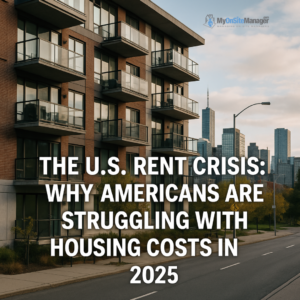The cost of renting a home in the United States has become one of the most pressing concerns for Americans in 2025. According to a recent Ipsos iSay survey, the majority of Americans—particularly renters—believe that the dream of affordable housing is slipping out of reach. With rising rents, high property prices, and increasing taxes, the financial strain on households is intensifying.
The Current State of Renting in America
-
51% of Americans now say renting is simply too expensive.
-
Nearly half (49%) of those surveyed believe property prices have reached unsustainable levels.
-
Concerns over high interest rates (34%) and taxes (35%) are adding to the overall financial stress.
-
Homelessness is also top of mind, with 33% citing it as a major issue connected to housing affordability.
This is more than just a financial problem—it’s becoming a societal challenge, affecting lifestyle choices, family planning, and overall quality of life.
Florida’s Renting Reality
Florida stands out in this conversation as one of the more expensive states to rent. In 2025, the average rent in Florida is approximately $1,955 per month, making it the 14th most expensive state in the nation for renters. This is particularly concerning for middle-income families, retirees, and young professionals who are moving to the state in search of better opportunities and warm weather, only to face soaring rent prices.
National Rent Trends
Across the country, more than half of renters spend over 30% of their income on housing costs, a threshold often used to define whether a household is “cost-burdened.” Being in this category means that a significant portion of income is tied up in rent, leaving less room for essentials like groceries, healthcare, and savings.
-
The price of a typical one-bedroom rental has surged by 65% since 2000.
-
Industry forecasts predict rent will rise another 1.5% by the end of this year, adding an average of $25 a month to rental payments. While that might not sound like much, it adds up to $300 more per year—the equivalent of a premium streaming subscription, or a month of groceries for some households.
What’s Driving the Rent Hikes?
Several factors are fueling the persistent increase in rental prices:
-
Housing Shortages – The U.S. continues to face a lack of affordable housing. Developers are building fewer low-to-mid-range rental units due to rising construction costs and stricter zoning laws.
-
High Demand in Urban Areas – Cities and desirable metro areas are experiencing population growth, which is pushing up rental competition and prices.
-
Inflation and Interest Rates – Higher interest rates are discouraging homebuyers, forcing more people to rent for longer, while inflation drives up operational costs for landlords.
-
Limited Wage Growth – While rent prices have climbed rapidly, wages have not kept pace, deepening the affordability crisis.
The Impact on Everyday Americans
The effects of high rent go beyond financial stress. For many, it has delayed or completely derailed major life milestones, such as:
-
Buying a home – More renters are unable to save for a down payment due to high monthly rent costs.
-
Starting families – Housing instability discourages long-term planning.
-
Building savings and retirement funds – A larger percentage of income goes to housing instead of long-term financial security.
Younger generations, particularly Millennials and Gen Z, are finding it harder to achieve the traditional markers of the American Dream. Many are choosing alternative housing arrangements, like co-living spaces, shared rentals, or moving back in with family to cut costs.
Possible Solutions and Policy Changes
Experts argue that increasing the supply of affordable housing is the most critical step in addressing this issue. Potential solutions include:
-
Incentives for developers to build affordable rental units.
-
Rent control policies in areas where rent hikes are outpacing income growth.
-
Tax breaks or credits for renters and low-income households.
-
Zoning reforms to allow more multi-family units and mixed-use developments.
Local and federal governments are also exploring first-time homebuyer assistance programs, which could help ease rental demand by allowing more people to transition into homeownership.
Final Thoughts
The high cost of renting is reshaping how Americans live, work, and dream. With more than half of renters feeling financially stretched, it’s clear that housing affordability is not just an economic challenge but a national priority that needs immediate attention.
The numbers don’t lie: Rents are higher, competition is tougher, and the American Dream feels more distant than ever. Without meaningful action from policymakers and industry leaders, this crisis could deepen in the coming years.
Source article:
Americans worry about high costs of renting – FOX 4 WFTX

